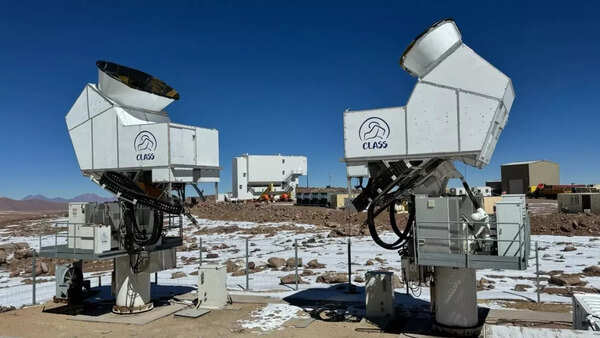
In a rare and remarkable scientific achievement, scientists have detected a 13-billion-year-old microwave signal from a period known as the Cosmic Dawn. It is a time just after the Big Bang when the first stars and galaxies began to form. What makes this achievement remarkable is that the signal was picked up not from space, but using Earth-based telescopes situated at high altitudes in the Andes mountains of northern Chile. The discovery was made by astrophysicists from the CLASS (Cosmology Large Angular Scale Surveyor) project. The project is funded by the US National Science Foundation. These weak signals of polarised microwave radiation provide rare insights into the early universe and reveal how the first cosmic structures influenced light leftover from the Big Bang.This is the first time such a faint and ancient signal has been observed from the ground. The breakthrough was achieved by the team led by Professor Tobias Marriage of Johns Hopkins University (JHU). This major feat defies previous assumptions that these signals could only be detected using space telescopes, due to the many technological and environmental obstacles faced by ground observatories.
What is the Cosmic Dawn that sent the 13-billion-year-old signal
The Cosmic Dawn refers to the time period between roughly 50 million and one billion years after the Big Bang. This is the period when the first stars, galaxies, and black holes began to form. It was like a dawn for the Universe. Before this phenomena, the universe was in a dark, neutral state with no sources of light. The earliest stars also known as Population III stars ignited nuclear fusion and emitted intense ultraviolet radiation that lit up the universe and began the process of reionization. This radiation ionized the surrounding hydrogen gas which allow light to travel freely through space for the first time.During this era, small, irregular galaxies started to assemble, and early black holes likely formed from the collapse of massive stars. These events fundamentally changed the nature of the cosmos. By studying light from this time, such as polarised microwave signals left on the cosmic microwave background, scientists can learn how the first luminous objects shaped the universe’s structure. The Cosmic Dawn marks the universe’s transition from darkness to light and holds key insights into how modern galaxies, including our own- Milky way, came to be.
Why detecting this signal is so difficult and significant
The microwaves that scientists are looking for from the Cosmic Dawn are extremely faint. It is about a million times weaker than regular cosmic microwave background radiation. These polarised microwave signals are measured in mere millimetres of wavelength and are easily drowned out by earthly interference such as radio broadcasts, radar signals, satellites, and even atmospheric conditions like humidity or temperature shifts.According to researchers, even under ideal conditions, detecting these signals requires highly sensitive and precisely calibrated instruments. CLASS telescopes were custom-designed for this task and strategically placed in high-altitude regions of Chile, where the thinner, drier air provides a clearer view of the universe.

How the CLASS team overcome the odds: A first feat from Earth
“People thought this couldn’t be done from the ground,” said Prof. Tobias Marriage. “Astronomy is a technology-limited field, and microwave signals from the Cosmic Dawn are famously difficult to measure. Ground-based observations face additional challenges compared to space. Overcoming those obstacles makes this measurement a significant achievement.”The CLASS team addressed these challenges by cross-referencing their data with results from previous space missions, such as NASA’s Wilkinson Microwave Anisotropy Probe (WMAP) and the European Space Agency’s Planck telescope. By identifying and eliminating interference, they were able to isolate a consistent signal from the polarised light. It confirmed that it originated from the early universe.
The polarised microwave light
Light becomes polarised when it bounces off surfaces or particles, causing the waves to align in a particular direction. A simple example is sunlight reflecting off a car hood, which creates a glare—one that can be reduced with polarised sunglasses. Similarly, ancient cosmic light that interacted with early matter became polarised.“Using the new common signal, we can determine how much of what we’re seeing is cosmic glare from light bouncing off the hood of the cosmic dawn, so to speak,” explained Dr. Yunyang Li, one of the study’s co-authors and a researcher affiliated with Johns Hopkins and the University of Chicago.
New path to explore the origins of the universe
The CLASS project has opened a powerful new window into understanding the origins of the universe. The study of these signals can help scientists to see how the first light sources interacted with matter. They can trace how early stars triggered the formation of galaxies. These processes shaped large-scale structures that still define the universe today. This research opens the door to new discoveries. It gives scientists a roadmap to explore the earliest and most mysterious parts of the universe without relying only on space missions.It proves that advanced ground-based technology, when combined with clever methodology and favourable locations, can rival even space telescopes in tracing the earliest chapters of cosmic history.This research validates the capabilities of Earth-based astronomy and paves the way for deeper studies into the birth of stars, the formation of galaxies, and the evolution of the universe itself.







